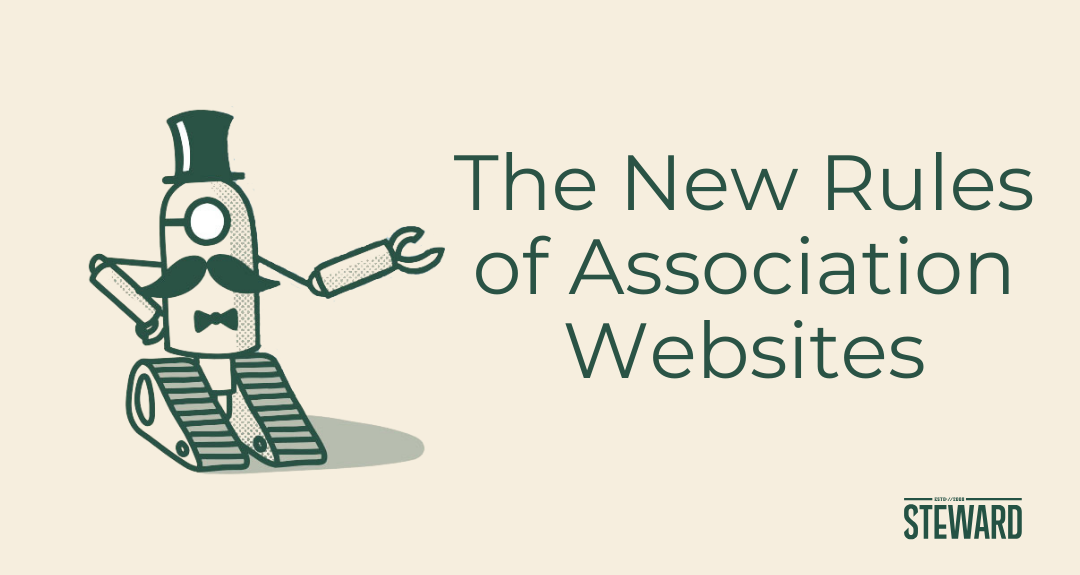
Your association’s website might be doing its job just fine.
And that’s the problem.
Right now, “fine” isn’t good enough.
If your site wasn’t built in the past 18 months, it’s likely out of sync with how people now search, navigate, and consume content.
The shift hasn’t been subtle. It’s here now.
It’s a behavior shift. An expectations shift.
We call it the “AI Shift.”
And it demands a strategy overhaul.
We put this guide together to light your way.
1. Old Thinking About Your Website Won’t Cut It
We’re no longer designing websites for people who browse.
We’re designing for people who “ask”…and then expect answers, immediately.
Your members - thanks to ChatGPT, Google’s AI Overviews, and more - have grown accustomed to:
- Conversational interactions.
- Predictive content delivery.
- Smart filtering and intuitive UX.
- Instant gratification.
According to Salesforce’s State of the Connected Customer report, the percentage of customers feeling treated like unique individuals (due to personalization) soared from 39% in 2023 to 73% in 2024.
Do you think your members feel the same?
Here’s how to tell if you’re falling short. If you still rely heavily on:
- Static navigation menus
- PDF resource dumps
- Overstuffed homepages
- Organizational language instead of member-centric phrasing
Then you have some work to do.
It’s time to reset how we think about what a website should do.
2. Here’s Why Old Thinking Won’t Work
Let’s take a closer look at how thinking about websites has shifted and why your current site may still be operating under assumptions that no longer serve your members.
❗️Old way:
Members will explore your site and navigate through menus to find what they need. You just need to organize things well and label them clearly.
✅ New way:
Members expect your site to surface what they need before they even ask. Browsing has been replaced by behaviors learned from AI tools: fast, frictionless, contextual.
❗️Old way:
Search bars and navigation menus are enough. As long as you have a logical menu and a functioning search bar, people will find what they’re looking for.
✅ New way:
Predictive, conversational experiences are the new bar. Members expect relevance without effort. If your site search doesn’t anticipate needs, it gets ignored.
❗️Old way:
Content is for everyone. One well-organized library or a good “Resources” section is enough to serve your diverse audience.
✅ New way:
Content must feel like it’s for me. Generic resources won’t cut it. Personalization isn’t a luxury anymore, it’s the baseline for usability.
❗️Old way:
Your navigation should mirror your organizational structure. If your departments are clear, your members will know where to go.
✅ New way:
Navigation should reflect member tasks, not your internal hierarchy. The structure should serve user intent, not internal clarity.
❗️Old way:
PDFs are helpful and professional. Posting documents as PDFs makes them easy to print, download, and distribute.
✅ New way:
PDFs are often ignored or abandoned. Members want direct answers and usable content, not 14-page downloads hidden in folders.
❗️Old way:
The biggest web pain point is editing content in the CMS. If you just make the backend easier for staff, the site will succeed.
✅ New way:
The real pain point is finding value for members and staff alike. A smooth CMS means little if the front-end experience falls short.
Let’s take one simple example: search.
If a member types “renew my certification” into your site’s search bar and gets zero relevant results, they’re not going to stick around.
Then they’ll Google it. Or ask ChatGPT. Or Perplexity.
And that’s the growing tension at hand today.
3. So What Should You Be Asking of Your Website?
Here’s what a future-ready, member-first website looks like. If your current site can’t do these things (or wasn’t designed to), it’s time to start asking bigger questions.
Surface Answers, Not Just Content
Can your website:
- Predict what someone might be looking for based on where they are and who they are?
- Serve up the most relevant content without requiring 3+ clicks?
Speak Human, Not Internal
Does your site:
- Avoid acronyms, jargon, and internal structure as navigation?
- Use clear, outcome-based language in headings and CTAs?
Adapt to Behavior, Not Just Roles
Does it:
- Personalize recommendations over time?
- Adapt content based on repeat visits or intent (e.g., job-seeker vs. long-time member)?
Combine Trust + Speed
Does your site:
- Empower humans where nuance matters (e.g., complex program decisions)?
- Let machines take over where automation helps (e.g., “Where do I log in?”)?
Embrace AI Without Abandoning People
Have you:
- Used AI to improve content surfacing, internal search, and personalization?
- Considered where AI fits. And where it doesn’t?
AI shouldn’t replace your website team. It should supercharge them.
But if your site doesn’t integrate or complement AI tools, your members will use tools that do.
4. Why a Website Rethink Should Be Priority #1 in 2026
It’s tempting to treat your website like a checked box. Something you deal with every 5 to 7 years, then ignore.
But let’s be real: nothing touches more parts of your association’s strategy than your website.
It’s how:
- Members engage (or disengage).
- Prospects decide whether to join or bounce.
- Stakeholders judge your professionalism.
- You deliver learning, advocacy, resources, events, certifications, and more.
Trust is low and attention is shorter than ever, so your site can’t be a passive brochure.
It has to work (as a trust delivery system), a learning hub, a conversion tool, and a member engagement engine.
According to Forrester, 81% of B2B buyers reported dissatisfaction with the provider they ultimately selected, often because the digital experience didn’t match their expectations.
So, if you think you “have time” for a redesign, this gap will only get worse.
5. So What Should You Do Right Now?
You don’t need to start a redesign project tomorrow.
But you do need to assess where you stand as well as where the friction is.
We’ve created a Website Readiness Quiz to help you:
✅ Spot old assumptions still baked into your site
✅ Ask better questions of your team and your technology
✅ Identify where member experience is breaking down
✅ Start thinking in terms of experience—not just updates
This is your reality check.
You’ll walk away with clarity, not overwhelm.
And if the answers lead to a redesign conversation? You’ll be ready.
Sources
- Salesforce, State of the Connected Customer, 5th edition: https://www.salesforce.com/resources/research/state-of-the-connected-customer/
- Forrester Research: https://go.forrester.com/blogs/the-future-of-b2b-buying/
When you're ready to talk the future, we're ready for you.

